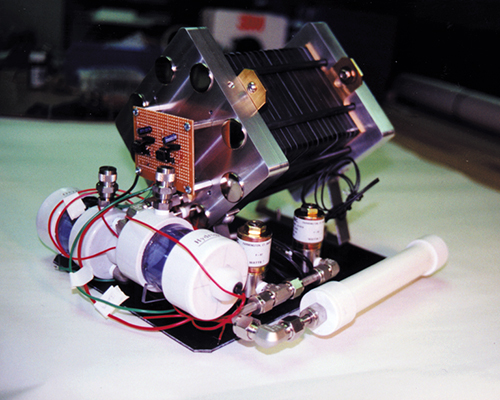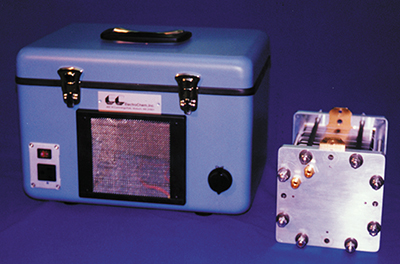Fuel Cells for Society
A new millennium technology headed for wider application in cars, homes, and power plants is the fuel cell. Operating like a battery, but never in need of recharging, fuel cells run on hydrogen and oxygen. The heart of a fuel cell consists of an electrolyte sandwiched between two electrodes. An electrochemical reaction between the gases produces electrical energy, water, and heat. The cell's waste product is water vapor, which can be used again in the system when broken down into hydrogen and oxygen. Clean running, efficient fuel cells are considered ideal for an energy-hungry world that is also endeavoring to reverse worrisome environmental issues.
ElectroChem, Inc., in Woburn, Massachusetts, has focused its engineering energies on solid polymer, or proton exchange membrane (PEM), fuel cells. The high-tech firm has sold hydrogen-oxygen fuel cells to the commercial market as a result of research performed under NASA's Small Business Innovation Research (SBIR) program at the Glenn Research Center.
Glenn and the NASA Wallops Flight Facility needed a hydrogen-oxygen PEM fuel cell for use aboard balloon-carried science platforms. The balloon-toted power system of choice is based on ElectroChem's PEM fuel cell technology sponsored by NASA SBIR funds.
NASA needed a high-power, long-duration power system to energize electronic equipment. Moreover, the power system had to deliver power continuously, in a safe, reliable manner, and under a wide variance in temperature and pressure. ElectroChem met the challenge. The final result was a working hydrogen-oxygen fuel cell stack producing 500 watts of power. Waste heat from the fuel cell maintained proper operating temperatures for the fuel cell, electronic equipment, and product water.
Similar to NASA's scientific balloons, business at ElectroChem has also soared skyward. The firm has gone from being solely a research company to commercializing products resulting in revenues of around $750,000 a year. Sales of its "fuel cell in a suitcase" have blossomed, with various government agencies and private industries, both in the United States and abroad, purchasing the energy-providing units. ElectroChem has started marketing its latest product, the EC-PowerPak200, a fan-cooled 200- watt fuel cell power system with automatic water draining and AC and DC outlets. Customers can plug an assortment of appliances, such as radios, into the fuel cell outlets.
Other uses for the PEM fuel cell include recreational vehicles, stand-alone regenerative power systems, rural electrification, and using it as a power source for underwater vehicles. ElectroChem is committed to further fuel cell research, aimed at reducing fuel cell prices to a range that residential homeowners can afford.
Recent studies of the fuel cell market suggest sales reaching $1.3 billion by 2003. ElectroChem's main goal is to develop small fuel cell power systems up to 5 kilowatts. This would allow the company to enter niche markets, then expand to cover off-grid applications in developing countries. To further critical research, the firm has established fuel cell laboratories in the United States and abroad.
"ElectroChem envisions a future where a sustainable global economy resides in harmony with a clean, healthful environment. Its mission is to provide fuel cell technology and products that this society will require for its energy supply," says Radha Jalan, CEO of ElectroChem.

Fuel cell portability and power makes ElectroChem’s products viable for an assortment of uses around the world

ElectroChem’s EC-PowerPak200 churns out 200 watts of power. Versatile fuel cells offer high energy while being virtually pollution free.













